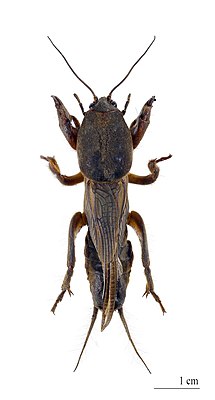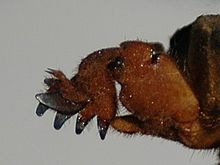European mole cricket
| European mole cricket | ||||||||||||
|---|---|---|---|---|---|---|---|---|---|---|---|---|

European mole cricket ( Gryllotalpa gryllotalpa ) |
||||||||||||
| Systematics | ||||||||||||
|
||||||||||||
| Scientific name | ||||||||||||
| Gryllotalpa gryllotalpa | ||||||||||||
| ( Linnaeus , 1758) |
The European or Common Mole Cricket ( Gryllotalpa gryllotalpa ), also Werre , Halbteufel (Switzerland) or Zwergel , colloquially G'schwer (Austria), is a long- probe cricket from the family of Mole Crickets (Gryllotalpidae).
features
The animals reach a body length of 35 to 50 millimeters, the females are shorter than the males. The body is red-brown to black and dark brown in color. Due to their front legs, which have been converted into powerful grave shovels, they are the only species in their family that are unmistakable in Central Europe . At the end of the abdomen, both sexes have long, flexible cerci . The yellowish front wings are short, only the same colored hind wings are fully developed. The sexes are very difficult to distinguish: the males, in contrast to the females, have a tuning fork-shaped vein bifurcation roughly in the middle of the wings.
Occurrence
The animals are found in Europe , North Africa and western Asia . They live on loose, moist, sandy to loamy soils with low grass cover. They are often found at the edge of water or in gardens. In the latter, they are often fought heavily, which is why they have rarely or have already been eradicated in some places.
Way of life
The European mole crickets, like all mole crickets, live in self-dug tunnel systems in the ground. They mainly feed on insects and their larvae , but also on plant roots, which is why they can cause damage in gardens and are therefore very unpopular. The animals can not only fly, but also swim well. They prefer more humid habitats , such as meadows near water. During the mating season, they create long-lasting, humming "rrrrr" noises through stridulation . Mating itself occurs in May and June. The females then lay 200 to 500 eggs in a burrow. The female guards both the eggs and the larvae that hatch eight to ten days later. These hibernate deep in the ground. They need five moults to develop and are fully developed after around 12 to 14 months.
Hazard and protection
- Red list FRG: V (on the pre-warning list).
credentials
- ↑ Federal Agency for Nature Conservation (Ed.): Red List of Endangered Animals in Germany. Landwirtschaftsverlag, Münster 1998, ISBN 978-3-89624-110-8
literature
- Heiko Bellmann : Der Kosmos Heuschreckenführer, The species of Central Europe safely determine , Franckh-Kosmos Verlag GmbH & Co KG, Stuttgart 2006, ISBN 3-440-10447-8 .
